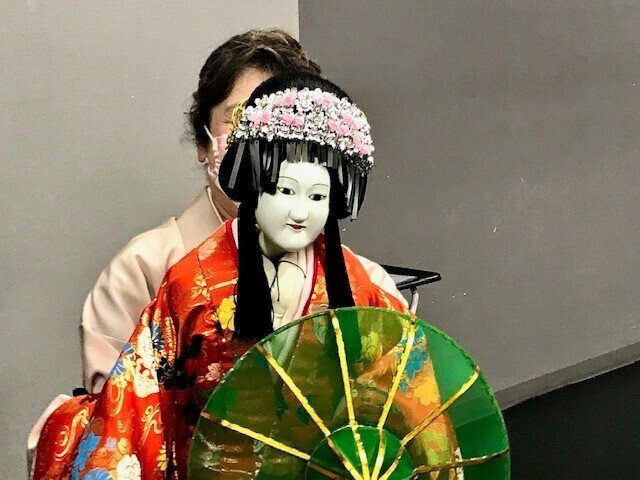
乙女文楽を文楽と比較し、見えてくるもの What you can see by comparing Otome Bunraku with Bunraku
前回に続き、乙女文楽をもう少し掘り下げて紹介しようと思っているが、そのためにはまず、人形浄瑠璃文楽との根本的な違いを少し説明させていただく。
Continuing from the last time, I would like to dig a little deeper into Maiden Bunraku, but for that purpose, I would like to explain a little about the fundamental difference from Ningyo Joruri Bunraku.
ご存知、無形文化遺産の「人形浄瑠璃文楽」は、乙女文楽と異なるのが人形遣い演じ手の数。乙女文楽は一人遣いに対し、文楽は三人遣いで人形を操る。さらに、乙女文楽の人形遣いはその名のとおり女性、そして文楽は男性である。この二つが根本的に異なる。
As you know, the intangible cultural heritage "Ningyo Joruri Bunraku" is different from Otome Bunraku in the number of puppeteers. Otome Bunraku is a one-person puppet, while Bunraku is a three-person puppeteer.
Furthermore, as the name implies, Otome Bunraku's puppeteers are women, and Bunraku is men. The two are fundamentally different.
文楽は、写真にあるように首(かしら)と右手を操作する主遣い(おもづかい)と左手を操る左遣い、そして足を操作する足遣いの三人構成で一体の人形を操作する。
As shown in the photo, Bunraku operates a doll with a three-person structure consisting of a main man who operates the neck and right hand, a left man who operates the left hand, and a foot manipulator who operates the legs.
乙女文楽は元々文楽から生まれたもので、文楽をより親しみやすくするために、昭和の初期に大阪で誕生。当時は、少女たちが楽しんでいた人形芝居で、現在は、見ての通り女性が一人で操作する伝統芸能として受け継がれている。
乙女文楽は、一人遣い用に工夫された人形を身にまとい芝居を行う。生の身体の動きを、そのまま直接に人形の動きに置き換え動かす。人形の身体と遣い手の頭とに左右一本ずつの細紐で連結させ、遣い手が首をふり頭を動かすことで人形の頭を操作する。手は人形の着物の袂の後ろから遣い手が手を突っ込んで、人形の手を持ち、足は遣い手の膝頭の下に結びつけている。
遣い手の身体への固定の仕方は、大阪では遣い手の二の腕の上部に人形をつけた腕金と呼ぶ碗曲した棒金具をひっかける腕金式が使われている。
Otome Bunraku was originally born from Bunraku, and was born in Osaka in the early Showa era to make Bunraku more familiar.
At that time, it was a puppet show that girls enjoyed, and as you can see, it is now inherited as a traditional performing art operated by women alone. Otome Bunraku performs a play wearing a doll designed for single use. The movement of the raw body is directly replaced with the movement of the doll. The body of the doll and the head of the puppeteer are connected with one string on each side, and the puppeteer operates the doll's head by shaking his neck and moving her head. The puppeteer thrusts his hand from behind the doll's kimono, holds the puppeteer's hand, and ties her feet under the puppeteer's kneecap. In Osaka, a doll is attached to the upper part of the upper arm of the puppet, and a curved bar is used to hook the puppet to the body.
演目、演出、音楽は「文楽」と基本的には変わらない。しかし、操る技術面では、三人で操る文楽の繊細な動きに劣らぬ技術水準が求められ、遣い手が代々、切磋琢磨しながら現代に継承されてきた。
The performance, direction, and music are basically the same as "Bunraku." However, in terms of manipulating technology, a technical level that is not inferior to the delicate movements of Bunraku operated by three people is required, and the technicians have been handed down to the present day while working hard for generations.
乙女文楽の一人遣いは、人形と遣い手の動きがより一体化された形なので、女性ならではの感性が生かされ、しなやかな動きを創り出しているのが特徴で、それが乙女文楽の美しさである。
Otome Bunraku's solo puppets are a form in which the movements of the doll and the puppeteer are more integrated, so the sensibility unique to women is utilized to create supple movements, which is the beauty of Otome bunraku.
改めて、乙女文楽の数々の演目をゆるりと鑑賞させていただきたくなる。
Once again, I would like to relax and appreciate the numerous performances of Otome Bunraku.


レポート & 写真 / 渡邉雄二 トップ右側写真 / 二ッポンドットコムより転載
Reported & Photos by Yuji Watanabe
よろしければサポートお願いします。日本の伝統文化に関心を寄せています。若いころに文化圏の異なる地域の方たちとの交流で日本のことをあまりにも知らなかったことに気づかされ、それがきっかけで広く浅く学んでいます。拙いレポートですが、お目に留めていただければ幸です。
